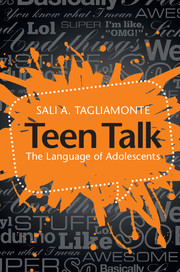Book contents
- Frontmatter
- Dedication
- Contents
- List of figures
- List of tables
- Preface
- 1 What's all the fuss about teen language?
- 2 Teens talking
- 3 Methods: how to tap teen language?
- 4 Quotatives: I'm like,“Oh my God!”
- 5 Intensifiers: upping the ante – super cool!
- 6 How do you start a sentence?
- 7 Sentence enders: finish with a flourish
- 8 Generics: stuffology
- 9 Just: just what?
- 10 Adjectives: the good, bad, and lovely
- 11 Other funky teenage features: You know what? I dunno. Whatever!
- 12 Internet language: everyone's online
- 13 Are they always going to talk like that?
- Notes
- References
- Author index
- Keyword index
Preface
Published online by Cambridge University Press: 05 June 2016
- Frontmatter
- Dedication
- Contents
- List of figures
- List of tables
- Preface
- 1 What's all the fuss about teen language?
- 2 Teens talking
- 3 Methods: how to tap teen language?
- 4 Quotatives: I'm like,“Oh my God!”
- 5 Intensifiers: upping the ante – super cool!
- 6 How do you start a sentence?
- 7 Sentence enders: finish with a flourish
- 8 Generics: stuffology
- 9 Just: just what?
- 10 Adjectives: the good, bad, and lovely
- 11 Other funky teenage features: You know what? I dunno. Whatever!
- 12 Internet language: everyone's online
- 13 Are they always going to talk like that?
- Notes
- References
- Author index
- Keyword index
Summary
My husband, Duncan, and I have five children, currently between the ages of 12 and 31. We have a busy household! Kids are always coming and going. Family suppers on Sunday evening can comprise what we call our “mini family” – us and one or two of our children – or we might have up to 16 attendees at the table, including the kids, their partners, and friends. Life with children – no matter what their age – is fraught with complexity and challenge. Among the best pieces of advice I ever received about children was the following: embrace the little opportunities in your day to spend time with your children, even if it's simply driving them and their friends all over the place or standing outside the front door for a brief chat as they wait for the bus. The next part of the advice is the difficult part: parents are advised not to talk, but listen. Up until the time I was a mother I had spent my career studying the language of older people, senior citizens/old age pensioners. Often these people inhabited small communities in remote locales. Their linguistic features were strange and wonderful. I thought I was studying the most interesting dialects in the world. But when my children reached pre-adolescence the kitchen table became an unexpected laboratory. As I listened to them talk I realized something even more interesting was going on. A whole new type of creativity and innovation in language erupted into my life in the most varied of words and phrases. I had entered a new frontier – one infrequently studied using natural unmonitored data – the language of teenagers.
This book comprises linguistic analyses of some of the most frequent, innovative, but also intensely ill‐reputed, features of teen language circa late twentieth and early twenty-first centuries. The studies are based on extensive corpora I have collected over 20 years of my academic career. The book is generously peppered with examples from these informal conversations with teenagers so that readers will virtually enter into the world of this sector of the population.
- Type
- Chapter
- Information
- Teen TalkThe Language of Adolescents, pp. xiii - xivPublisher: Cambridge University PressPrint publication year: 2016

